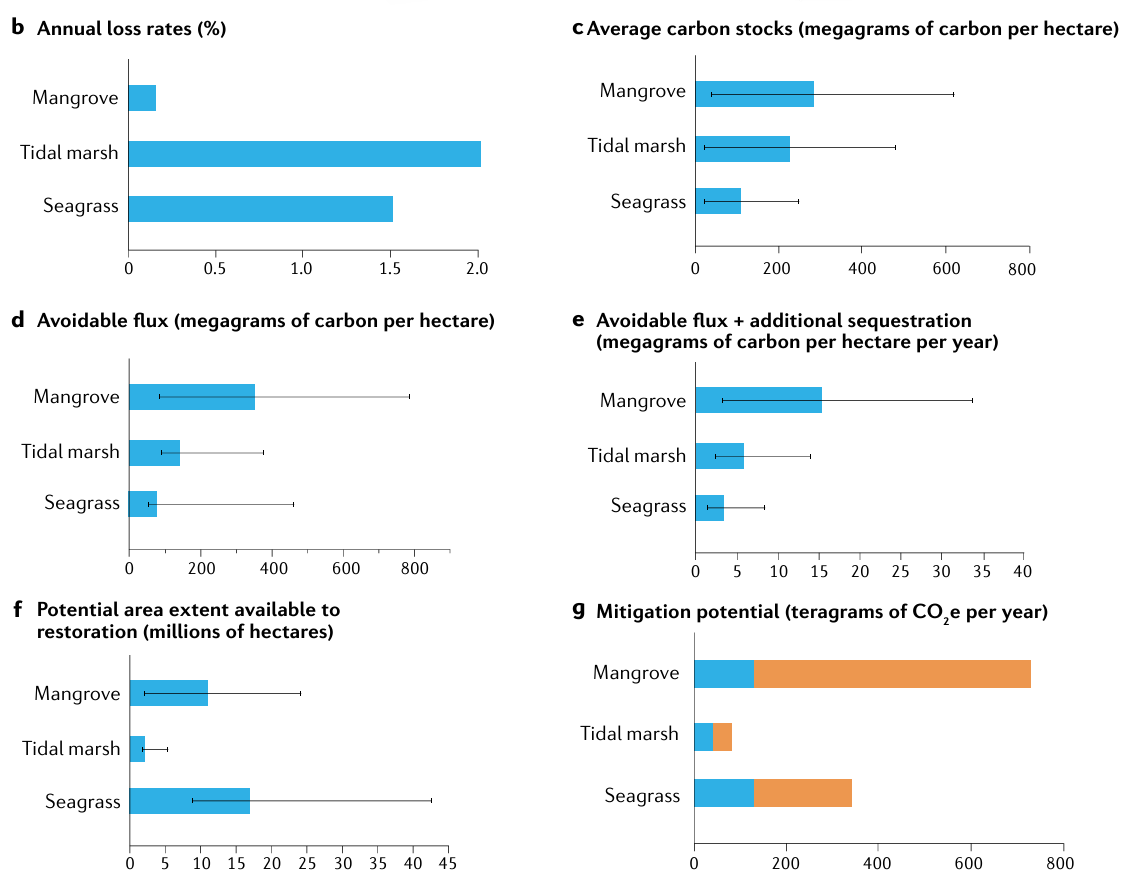November 1, 2021 | Nature Reviews Earth & Environment | Source |
Introduction: An international research team from Australia, USA, Singapore, UK and Saudi Arabia, led by Deakin University (Australia) evaluates the global potential of blue carbon ecosystems (BCEs)—mangrove forests, tidal marshes, and seagrass meadows—as a climate-smart, win–win solution that addresses carbon sequestration gaps while delivering vital co-benefits such as coastal protection, fisheries enhancement, and livelihood support. Using global mapping and ecosystem modeling, the study identifies opportunities and barriers for extensive restoration efforts.
Key findings: Despite occupying only about 0.5% of the seafloor, BCEs store over 50% of oceanic carbon. Globally, they hold an estimated 30,000 teragram (Tg) of carbon across ~185 million hectares. Protecting existing BCEs could avoid 304 Tg CO‚āāe emissions annually, while restoring lost or degraded areas—particularly mangroves—could draw down an additional 841 Tg CO‚āāe per year by 2030, amounting to ~3% of global fossil fuel emissions (2019–2020). However, considerable uncertainties persist due to gaps in mapping, methodological inconsistencies, and limited carbon stock data for seagrasses and tidal marshes.
Major drivers of BCE loss include physical alteration, pollution, invasive species, and land-use change—often driven by aquaculture, agriculture, and infrastructure expansion, especially in Southeast Asia. Restoration approaches vary: passive techniques like improving tidal connectivity may be more effective and cost-efficient than active planting, which is often unsuccessful, especially for seagrasses. Yet, only ~1.5% of BCEs are included in marine protected areas, highlighting major untapped potential for conservation. Moreover, a key policy challenge is demonstrating “additionality”—the requirement that carbon abatement must result directly from project actions not already mandated.
The study emphasizes the need for better spatial data, scalable restoration methods, and stronger governance frameworks. It also highlights emerging ocean-based climate solutions, such as seaweed farming and kelp forest conservation, as promising future avenues. Integrating BCEs more fully into national climate strategies and carbon markets will be critical for realizing their full potential in global mitigation efforts.

Figure | Loss rate, carbon stocks, avoidable fluxes and mitigation potential for each BCE.
b | Estimated annual loss rates (%) for seagrass (between 1879 and 2006), tidal marshes and mangroves (between 2000 and 2012). c | Global average soil carbon stocks (for mineral soils) per area (megagrams of carbon per hectare). d | Avoidable flux for avoided coastal wetland impacts the pathway (megagrams of carbon per hectare). e | Avoidable flux and additional sequestration rates (95% CI) for the coastal wetland restoration pathway (megagrams of carbon per hectare per year). f | Potential area extent available to restoration (millions of hectares). g | Maximum mitigation potential from avoided emissions due to conversion (dark blue; mineralization of carbon stocks in biomass and soils, and loss of carbon sequestration potential (teragrams of CO2e per year)) and maximum mitigation potential from restoration (orange; mineralization of carbon stocks in biomass and soils, and recovery of carbon sequestration potential (teragrams of CO2e per year)). Maximum mitigation potential for avoided emissions assumes that 100% of carbon stocks are lost following habitat loss (1 Mg ha = 1,000,000 ha and 1 Tg = 1,000,000 Mg). Uncertainty estimates (grey bars) represent 95% CIs. Tidal marshes and seagrass meadows do not have information available on potential for avoided emissions per country.





